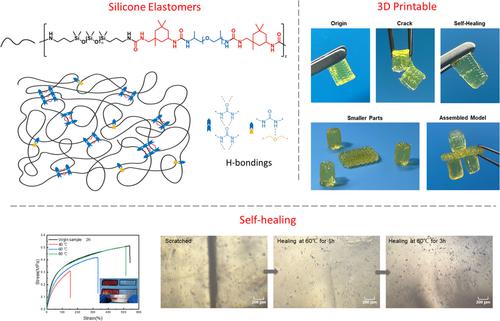当前位置:
X-MOL 学术
›
J. Polym. Sci.
›
论文详情
Our official English website, www.x-mol.net, welcomes your
feedback! (Note: you will need to create a separate account there.)
A 3D printable and self-healing polydimethylsiloxane elastomer
Journal of Polymer Science ( IF 3.9 ) Pub Date : 2023-07-25 , DOI: 10.1002/pol.20230427 Zi‐Xing Wei 1 , Hong‐Qin Wang 1 , Cheng‐Hui Li 1
Journal of Polymer Science ( IF 3.9 ) Pub Date : 2023-07-25 , DOI: 10.1002/pol.20230427 Zi‐Xing Wei 1 , Hong‐Qin Wang 1 , Cheng‐Hui Li 1
Affiliation

|
Silicone elastomers are broadly used in various fields because of their unique properties, such as flexibility, durable dielectric insulation, and excellent stability in hash environments. As a result, three-dimensional (3D) printing of silicone elastomers is frequently required to construct personalized structures. However, existing 3D-printing of silicone elastomers are less accurate, difficult to maintain shape, or require doping modification with thixotropic agents. Moreover, common 3D-printable silicone elastomers do not have self-healing capability, so they have to be discarded upon damaging. Herein, by introducing hydrogen bonds to improve the shape retention ability and induce network reversibility, we have developed a self-healing polydimethylsiloxane elastomer, which can be readily 3D-printed by fused deposition modeling (FDM) technology. We believe that this new silicone elastomer would be useful in the field of biomedical materials, flexible electronics, medical inserts, soft robots and so on.
中文翻译:

一种可 3D 打印且自修复的聚二甲基硅氧烷弹性体
有机硅弹性体因其独特的性能,如柔韧性、耐用的介电绝缘性以及在哈希环境中出色的稳定性而被广泛应用于各个领域。因此,经常需要对有机硅弹性体进行三维 (3D) 打印来构建个性化结构。然而,现有的有机硅弹性体 3D 打印精度较低,难以保持形状,或者需要使用触变剂进行掺杂改性。此外,普通的3D打印有机硅弹性体不具有自愈能力,因此在损坏后必须丢弃。在此,通过引入氢键来提高形状保持能力并诱导网络可逆性,我们开发了一种自修复聚二甲基硅氧烷弹性体,可以通过熔融沉积建模(FDM)技术轻松进行3D打印。我们相信这种新型有机硅弹性体将在生物医学材料、柔性电子、医疗插入物、软机器人等领域发挥重要作用。
更新日期:2023-07-25
中文翻译:

一种可 3D 打印且自修复的聚二甲基硅氧烷弹性体
有机硅弹性体因其独特的性能,如柔韧性、耐用的介电绝缘性以及在哈希环境中出色的稳定性而被广泛应用于各个领域。因此,经常需要对有机硅弹性体进行三维 (3D) 打印来构建个性化结构。然而,现有的有机硅弹性体 3D 打印精度较低,难以保持形状,或者需要使用触变剂进行掺杂改性。此外,普通的3D打印有机硅弹性体不具有自愈能力,因此在损坏后必须丢弃。在此,通过引入氢键来提高形状保持能力并诱导网络可逆性,我们开发了一种自修复聚二甲基硅氧烷弹性体,可以通过熔融沉积建模(FDM)技术轻松进行3D打印。我们相信这种新型有机硅弹性体将在生物医学材料、柔性电子、医疗插入物、软机器人等领域发挥重要作用。


















































 京公网安备 11010802027423号
京公网安备 11010802027423号